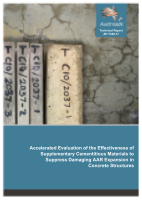Bridges

- Publication no: AP-T328-17
- ISBN: 978-1-925671-09-4
- Published: 22 September 2017
- PDF (free) Download
This report provides the results of testing of three potentially reactive aggregates by the accelerated mortar bar test (AMBT) and the concrete prism test (CPT).
The tests were conducted using reference mixes, which contained plain Portland cement as binder, as well as mixes which incorporated different supplementary cementitious materials (SCMs) at various cement replacement dosages. The SCMs were used as countermeasures against alkali-aggregate reaction (AAR) in concrete.
The purpose of the testing program was to investigate whether the much faster AMBT method could be employed instead of the slow CPT method for the evaluation of the efficiency of the SCMs to suppress AAR.
The comparison between the AMBT and CPT methods indicated that the already-practised period of 21 days seems to be the shortest time that the effects of SCM can be detected, and produces the best agreement between the results of the two methods.
The results also showed that the dosage of SCMs for AAR suppression was highly dependent on the nature of the aggregate.
As a result, a universal rule cannot be prescribed. It is suggested that long-term field tests be undertaken for aggregates from various sources, so that a more reliable database can be generated for each area.
- Summary
- 1. Introduction
- 1.1. Purpose
- 1.2. Issue
- 1.3. Scope of Project
- 2. Review of Literature
- 2.1. Test Methods for Detecting Reactive Aggregates
- 2.2. Application of SCMs for the Mitigation of AAR
- 2.3. Rapid Assessment of the Efficacy of SCMs in Suppressing AAR by the AMBT Method
- 2.4. Conclusions of the Literature Review
- 3. Experimental Work
- 3.1. Materials
- 3.1.1. Coarse Aggregate
- 3.1.2. Binder Components
- 3.1.3. Binder Combinations
- 3.2. Test Methods
- 4. Results
- 4.1. AMBT Results
- 4.2. Analysis of AMBT Results
- 4.3. CPT Results: First Run
- 4.4. Analysis of CPT Results from the First Run
- 4.5. CPT Results for the New Batches of Aggregates
- 4.6. Independent Results from Swinburne University
- 4.7. Effect of SCM Content on Expansion – New CPT Results
- 4.8. Correlation between AMBT and CPT Results
- 4.8.1. Rhyodacite Aggregate
- 4.8.2. Hornfels Aggregate
- 4.8.3. Gneissic Granite Aggregate
- 5. Conclusions
- References
